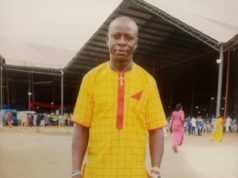IN JUNE 1996, I had perhaps my first major test as a journalist from the Niger Delta. The Rivers State government under Colonel Dauda Komo had decided to revamp the state newspaper, and a new crop of journalists was being recruited to do a good job.
Kudo Eresia-Eke was serving as Commissioner for Information under that government. He hired the services of Taijo Wonukabe, a Lagos-based media relations firm, to get the best of journalists of Rivers stock together, and propel them to re-brand the paper.
I was in Lagos when l was invited to join the team. I had two weeks to put together a proposal as to what I would do if I were to become editor of the Sunday paper. One idea was to run a weekly magazine story, dwelling on a subject of popular interest.
In my capacity as editor of the paper, I was to write the first story and set the tone for the paper. The subject was Harcourt. Who was the founder of Port Harcourt? Why was this port named after Harcourt?
Dagogo Ezekiel-Hart, the editor in chief, was generous enough to sign out allowances for every reporter and editor to go in search of that elusive fellow after whom the young city was named. Go in search of the white man who first arrived the city known as Port Harcourt today.
At that time, in 1996, the internet was still far from our newsroom. We had to do the leg work, go around town, go around Nigeria, in search of Harcourt. One line editor was despatched by air to Lagos. Another was deployed to the national archives, Enugu, and all-around Port Harcourt, our reporters combed the ancient hives for the story of this man called Harcourt.
In the end, all that mass of information was dumped upon the desk of the editor, Tide On Sunday, and I was obliged to make sense of it all. Long before the photograph came to my attention, the following story was published in the maiden June 30, 1996, edition of The Tide On Sunday. It is served fresh in the pages of Coastline News Network, your local CNN…
HARCOURT WAS born. Harcourt lived. Harcourt died. That much is obvious. Harcourt was white. His Caucasian origins showed clearly in his aquiline nose, his thin lips and the pale pigmentation of his skin. To the local folk with whom he first came in contact in the early days of the colonial era, he spoke with a curious nasal accent like every white man in the neighbourhood.
Like the officers of Her Majesty the Queen who were dispatched to the colonies of the West Coast of Africa, Harcourt’s dress sense kept to the strict regimen of a starched khaki shirt with a leather strap running from one shoulder into a pair of stiff knee-length shorts. Jungle boots and a wide-brim hat over his frazzled peroxide hair completed his formal outfit.
That much is presumable about the man. Almost eighty years after he made his appearance in the history books, the rest of his personality, private life and career appear to be an enigma doubly wrapped in mystery. Who indeed was this Harcourt, the only white man to have bequeathed his name to a capital city in all of Nigeria? Did he have a family? What was his full name? What drove him to, of all places, Port Harcourt? The questions demand sensible answers.
Yet historians seem to be at a loss about the true identity of this pioneer city builder. The primary lead goes back to 1912 when Sir Frederick Lugard, the first Governor-General of Nigeria sought to open up trade routes from the hinterland to the coastal region. Colonial officers were thus dispatched to survey the vast land and seal their territorial rights over it by negotiation or force.
Earlier, in 1890, following the suggestions of a certain Sir Lewis Harcourt on the floor of the British parliament, the need to site a port that would link the Southern and Northern protectorates reached fever pitch. Inevitably, the search led the colonialists into a confrontation with some coastal tribes.
Between 1891 and 1896, the drums of insurrection had sounded from Benin to Brass. When Lugard took effective control by the turn of the century, planting the Native Authority system and the famous Indirect Rule principle, a good number of the kingdoms had compromised their positions.
At about the same period, another man arrived the scene and appropriated the zeal behind the search of a suitable port. He was acting on behalf of Lugard. His name was A. B. Harcourt Esquire.
Were there two Harcourts then? If both Lewis and A. B. were united in the same purpose, to whom did the credit really go when the port was name Harcourt? Responses were as different as night from day when The Tide On Sunday went to town, lugging the questions. By 1912, entry into the port was through Bonny by sea.
Harcourt is believed to have berthed on the shores of Okrika and approached the paramount ruler of the time, Chief Benjamin Kalio, requesting virgin land where he could establish a sea port. Kalio was a living witness to the indignity of banishment meted out to King Jaja of Opobo and Chief Pepple of Bonny by the British.
In 1896, Chief Igbani Gika of Okrika had been banished in the same way. So, Kalio took Harcourt’s story with a sceptical pinch of snuff. He paddled Harcourt through the creeks for days and finally allocated Orukiri, an evil forest, to the white man.
It turned out that Harcourt could not have asked for a better place. So avid was his love of the allotment that he negotiated for more land, three miles down into Iguocha as the area was then called by the people of Idiobu. A controversy between the original landowners necessitated a settlement.
In 1913, a lease agreement was signed by all three parties under the supervision of R. Hargrove. To signify that the land was out of the squabbling Okrika and Idiobu people, and for want of a better name for the settlement that would grow into a thriving port, the British government named the evil forest and its environs after their man, Harcourt.
N.C. Ejituwu, a professor of history at the University of Port Harcourt, believes that Sir Lewis Harcourt was the man who approved the search for a suitable port in the Niger Delta. According to the historian, the Cross River valley had been considered before the delta was proposed.
What brought about the change was the discovery of coal in Udi Hills, Enugu. Said he: “The opening of Port Harcourt signified the collapse of the old ports in Bonny, Brass, Opobo, Abonnema, Okrika and others that had at various times in the past appropriated the wealth from overseas trade with implications for rivalry.”
Sir Lewis, according to Ejituwu, assessed the situation rightly and sought to rally the various assets around the port, and encourage the hinterland and delta peoples to interact with the British. As Secretary of State for the Colonies, Sir Lewis Harcourt lived in London, far away from the port he is supposed to have founded.
But he had cause to argue fiercely on the floor of the British parliament for the amalgamation of the Southern and Northern Protectorates as a safety valve for relieving the British of its excessive financial burden. On June 27, 1912, in the House of Commons Debate, Column 514, he is quoted inter alia as saying: “I hope that we may be able to set a short term to Grant-In-Aids and at the same time relieve the Treasury from its liabilities and the protectorate from Treasury Control.” Sir Lewis Harcourt won his fellow parliamentarians to his side.
A.B. Harcourt, on the other hand, worked closely with the Governor-General in Lagos. Reputed to be a territorial warrior, he is reported to have been mandated to act as the principal signatory to the treaties signed with the chiefs of Ndoki, Ukwe, Ngwa, and other communites, to cede the area along which the rail line was to run from up country to the coast. In 1900, A.B. Harcourt, District Commissioner for Gom River Division, was recommended for promotion to Travelling Commissioner.
A letter dated May 29, 1900, and signed by Mr Moor, a superior colonial officer, stated that Harcourt’s promotion would not attract travelling allowance in excess of one hundred pounds. He replaced Captain DCG Heineken who had been seconded to the Third Amphibious Brigade of the West African Frontier Force, WAFF. The letter was addressed in formal terms to the Secretary of State for the Colonies.
Was it by any chance possible that Sir Lewis Harcourt was the officer in charge of that portfolio at the time? Perhaps. Perhaps not. At any rate, the authentic Harcourt may be traced to the Noman family in eleventh-century France.
Norman Turchetil, a wealthy landowner who lived in the first quarter of the century, was the patriarch of a long line of Harcourts who ventured far beyond their traditional home in the northwest of France. The principal ancestor of the English Harcourts was a grandon of Tuchetil called Ivo, who inherited the family’s acquisitions in England.
But perhaps the closest relation to the founder of Port Harcourt was Sir William Granville Venables Vernon Harcourt who lived between 1827 and 1904. According to historical accounts, William Harcourt was a liberal parliamentarian who was enamoured of Gladstone’s politics.
A versatile man of letters, he was a journalist, mathematician and lawyer who became a Queen’s Council in 1966. Appointed Solicitor General in Gladstone’s government, Harcourt became Home Secretary when the Liberal Party gained power in 1880. Six years later, he was sworn in as Chancellor of the Exchequer.
After Gladstone’s retirement, Sir William became leader of the Liberal Party in the House of Commons, the highest political office he was to hold in his lifetime. An essentially rebellious aristocrat, Harcourt continued to lambast the policies of the succeeding Prime Minister, Joseph Chamberlain. He passed on in 1904.
It is not at all certain whether or not this statesman was an uncle or the direct father of our Harcourt, but the contiguity in age between the two appear to allow enough room for a father-son linkage. Sir William died at the venerable age of seventy-seven.
Both Harcourts who served in the colonial government in Nigeria were probably in the 30-40 year bracket. The coincidence is hard to ignore. Even so, two different men going by the name of Harcourt were serving in the Lugard administration in Nigeria.
The one was Lewis Harcourt, Secretary of State for the Colonies. The other was A.B. Harcourt, who began his political career as a Consular Agent. Port Harcourt may have been named after either of them.
The little port built by Harcourt which was to grow into a vibrant metropolis, attracting people from far and near was, in fact, an evil forest that has been thoroughly sanitized by civilization. Harcourt himself had predicted the outcome in 1912. Many years later, the prediction has come true. Apart from Jos, perhaps, Port Harcourt is the only city in Nigeria that has become a tourist delight in itself.
As E.J. Alagoa, emeritus professor of history puts it, “the colonialists showed from the onset that they would settle in the city. They, therefore, built it to taste. The two most important places were the port complex and the railway station. They also built the GRA where the administrators would live. They built the post office and designed Aggrey Road and Creek Road in genetic similarity. Areas were mapped out for parks and incinerators, while churches were built along Aggrey Road.”
Designed to look like a chessboard, with streets crisscrossing each other at right angles toward the southern end of the town, Harcourt’s port was also the home of gardens. In the reserved areas where Harcourt and his colonial peers put up residence, shady trees grew in abundance, apparently to keep the tropical heat in check.
Even so, they were grown along with straight, regular patterns. The feature of the city was to abide long enough to earn it the sobriquet of Garden City. Alagoa recounts that the lighting around the exclusive sections of the town was so glorious and bright that “one could read a newspaper while walking along the streets at night.”
Social life, according to more historical accounts, flourished at the European Club which used to be at the present site of the Port Harcourt Club. It contrasted in serenity with the African Club built apparently to cater to the leisure hours of the local labour force.
Solid quarters, some of which stand to this day, were also built to house workers in the colonial service, in much the same way that the waterfront, with its bulk of sea liners and smaller craft, was developed along the harbour for mariners.
Like Harcourt who bequeathed his name to the entire city, successive colonialists and missionaries left their mark in smaller ways. Winston Churchill, Harold Wilson, Bernard Carr and Potts Johnson are among the more prominent names by which some streets are known to this day.
Harcourt — Lewis, AB or whoever he was — converted an evil forest and a sprawling landscape into a prosperous settlement. He was rewarded with having the place named after him, the only white man in Nigerian history to have had the honour done him. The city has remained the only truly urban centre in Rivers State right up to the present. But who was he? Where did he die? And just what manner of man was this Harcourt?
© Josef Owei



 ADVERTISE WITH US. Call or send a Whatsapp message 08070950313
ADVERTISE WITH US. Call or send a Whatsapp message 08070950313


 ADVERTISE WITH US. Call or send a Whatsapp message 08070950313
ADVERTISE WITH US. Call or send a Whatsapp message 08070950313






